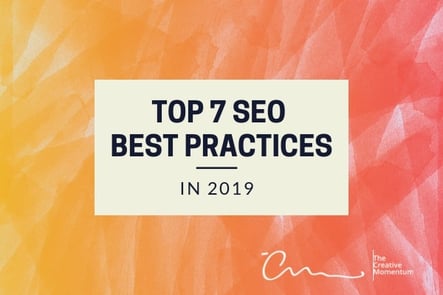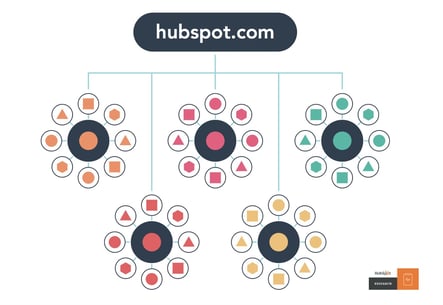
Around this time last year, we did a roundup of the top SEO trends in 2018 that website owners could use to improve their page rankings. We hope you took some of those tips on board and managed to improve your SERP results over the past year!
As we’re now in Q4 of 2018, we figured it’d be the perfect time to do another SEO roundup—this time discussing seven of the best SEO practices you can use to boost your results as we move into 2019.
1. Don’t Fight for Dominance—Blaze Your Own Trail
There’s a marketing theory called the “Blue Ocean Strategy” which argues that companies achieve greater success by seeking out uncontested market space rather than fighting head-to-head with competitors. (Competing in clear blue waters rather than shark-filled, bloody waters. You get the idea.)
This is an important tenet of SEO. The more crowded the field, the harder it is to get noticed. If you want to rank higher in the SERPs, it’s to your benefit to look beyond what your competitors are doing and seek out new topics that haven’t been explored.
Sites like Google Trends or BuzzSumo are your friend, here. To illustrate this idea, below we compare the interest in the terms “content marketing 2018” and “content marketing 2019”. Obviously, everyone’s talking about 2018 content marketing IN 2018—but there aren’t many indexed pages covering the 2019 strategies midway through the year. As 2019 approaches and the gap shrinks, more people start talking about it.

Your job is to find that sweet spot where you can confidently provide advice before your competition bloodies the waters. By the time they jump on board, your page will already be indexed and you’ll be the established authority.
2. Try for Featured Snippets
Everybody loves featured snippets—those handy text boxes that pop up when we search and provide quick answers to our questions without needing to click a link. They’re becoming a particularly important part of the UX as convenience becomes the norm and mobile and voice searches rise in prominence. Below is an example featured snippet...on featured snippets!

But their role in good old-fashioned web SEO can’t be overstated—according to research from HubSpot, content with featured snippets doubled their click-through rates. While the exact process for selecting this snippets isn’t precisely known, HubSpot’s research identified a few trends:
- Ranking among the top five results of the SERPs
- Keyword usage on-page, including their semantic relevance to the keywords being searched
- Assembling your page’s structure to support simple, cohesive answers
- Using logical subheadings that provide an overview of the article
3. Kill Your Zombie Pages
We know, zombie references are passé. Very 2010. But your website is probably infested with them, even if you don’t realize it. Zombie pages are web pages that provide no real value to your traffic, authority, or web presence, most often appearing as old or outdated content. They most often take the form of:
- Duplicate content
- Outdated blog posts
- Aging press releases
- Pages for products that nobody buys
- Pages that shouldn’t be indexed (such as search result pages)
Every site has a few, and they’re not always a big deal. But when your site has hundreds, or thousands, it can be detrimental to your SEO. Zombie pages bloat your sitemap with numerous pages that Google deems low-quality, as they earn no traffic or engagement.
Kill these pages where possible—by setting your results pages to “no-index”—and repurpose content as needed (such as combining three old blog posts into a single piece of long-form content that supports engagement and encourages longer time spent on-site).
4. Cluster Your Content
Topic clusters are a hot new SEO tool that many sites haven’t yet used, which is a pity, as search engines are changing their algorithms to favor content structured this way.
Topic clusters involve changing your website structure to have single “pillar” pages acting as primary hubs of information. From this hub, each subtopic (or cluster) has its own page connected via link. Think of it like spokes on a wheel. Every piece of cluster content connects back to the hub, with the pillar page providing the primary anchor point for navigation.

Both users and search indexers like knowing how pages are connected to one another at a glance. Pillar pages are a great way to structure your content to support this goal.
5. Prepare for Voice Search
The importance of voice search for SEO in 2019 should come as no surprise. If you review the search data put out by Google, we can see that over half of all search queries now come from mobile devices, and around 20 percent of queries made on mobile apps are now voice-based. And with voice assistants like Siri, Alexa, and Google Home becoming more popular, we expect this growth to be consistent for a while.
Backlinko researched voice queries and SEO, and came up with some good advice on how to get ahead in this arena:
- Optimize your content to align with the type of queries you’d hear in voice searches
- Research on long-tailed keywords that closely mirror how users actually speak
- Make sure your pages load quickly
- Prioritize long-form content (the average word count of a voice search result pages was over 2,300 words).
6. Land Conversions With Video
We all know that Google gives ranking points to websites with high user retention, longer time spent on-page, and lower bounce rates. Ipso facto, if you engage your viewers, you will rank better in the SERPs.
This applies to every page on your site, but here, we’re recommending a particular tactic: Incorporating video in your landing pages. Research suggests that video on landing pages can increase conversions by as much as 80 percent by engaging viewers directly, building trust, and holding their attention for longer than other mediums. Naturally, these benefits translate to longer time spent on-site and increased engagement with your content.
7. Recognize the Role of the User Experience
As always, the user experience will play a key role in 2019’s SEO. In fact, most of our above advice is based on improving the user’s experience with your brand:
- Exploring new topics that users will be interested in
- Providing simple, effective content that will get featured in snippets
- Pruning your site of unnecessary pages
- Organizing your page in a structured, intuitive hierarchy
- Adjusted your content to cater to a user-preference for voice
- Leveraging video to provide fast information that supports decision-making.
The user experience is the heart of all website and marketing goals, and 2019 will be no exception. Keep this in mind as you apply the above strategies. Yes, quality SEO is about increasing your odds of ranking well with Google, but even more importantly, it’s about establishing yourself as an authoritative and trustworthy resource that your visitors can count on.
And as always, if you need help bringing these strategies to life, the skills of a qualified web development company might be just the thing you need.


